Alkene reactions are the foundation for all future organic chemistry reactions and mechanisms. To help you build that solid foundation I've put together this short quiz testing your knowledge of reactions, reagents, products and additional molecule concepts.
These questions range from medium to tricky and should be completed AFTER you've studied my Alkene reaction video series since each video already contains a few simple practice problems.
Take your time and think through each question. If you're not sure how to proceed click the ‘hint' link for the related mechanism tutorial video. Once finished scroll down and grab a free copy of the solutions.
Alkene Practice Question 1
Identify the reagent and solvent required to carry out this reaction

Hint – if you're stuck on this reaction watch this video to learn the mechanism
Alkene Practice Question 2
Identify the product formed when this alkene reactions with Cl2 in water. Pay particular attention to stereochemistry.

Hint: There may be more than 1 product. For help with this reaction click to watch the mechanism video
Alkene Practice Question 3
Identify the product formed when the following alkene is reacted with BH3 and THF, then followed up with H2O2 and NaOH

Hint: This is an anti-markovnikov reaction.
Alkene Practice Question 4
Identify the starting alkene that will yield the product shown when reacted with chlorine in CCl4. Pay particular attention to the stereochemistry of product.
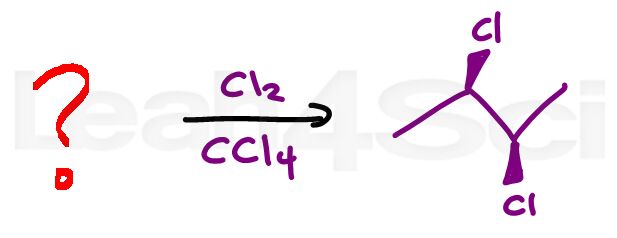
Hint: Stuck on the stereochemistry of this question? Watch the reaction video here to review this reaction
Alkene Practice Question 5
Identify the reagent and solvent required to transform the starting cycloalkene to the given ether.

Hint: Water and alcohol undergo similar reactions. Click for the mechanism video
Alkene Practice Question 6
Identify the product when the following alkene reacts with Hg(oAc)2 in alcohol followed by NaBH4

Hint: Pay close attention to each of the given reagents. Stuck on this reaction? Click for the reaction video
Alkene Practice Question 7
Identify the product formed with the given bicycloalkene reacts with Bromine in CH2Cl2. Be sure to include all possible products.
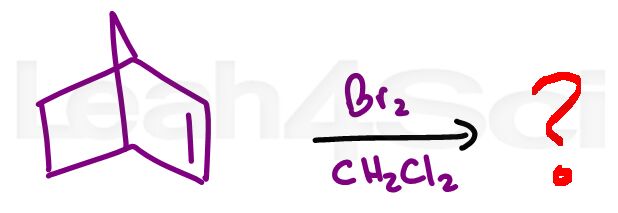
Hint: Don't let the complexity of the molecule throw you off. If you know this reaction you'll get the product
Alkene Practice Question 8
Identify the product formed when this alkene reactions with sulfuric acid in an ethanol solution
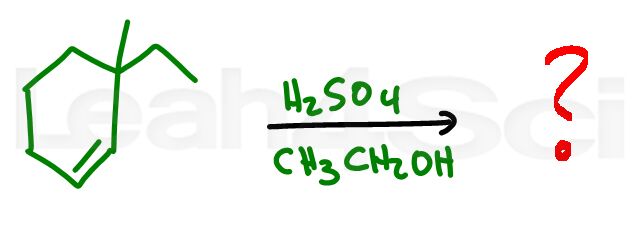
Hint: Pay special attention to the reagents, solvents, and stability of the intermediates. Stuck? review this video
Alkene Practice Question 9
Identify the product formed when the given alkene reacts with hydronium
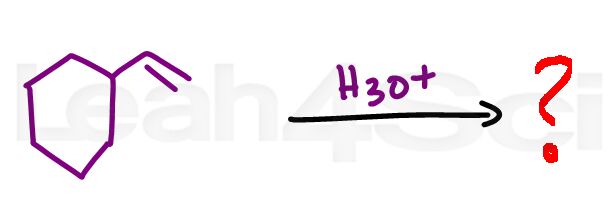
Hint: Pay special attention to the stability of the reaction intermediate. Need help? watch this video
Alkene Practice Question 10
Identify the reagents required to bring about this alkene to alcohol transformation.

Hint: Consider how the intermediate impacts the regioselectivity of this reaction. Stuck? Watch this video.
Alkene Practice Question 11
Identify the product formed when the alkene below reacts with bromine in a methanol solution.
Hint: Consider how the solvent impacts the intermediate. Need help? Watch this video
Alkene Practice Question 12
Identify the product when the alkene below reacts with sulfuric acid in water.
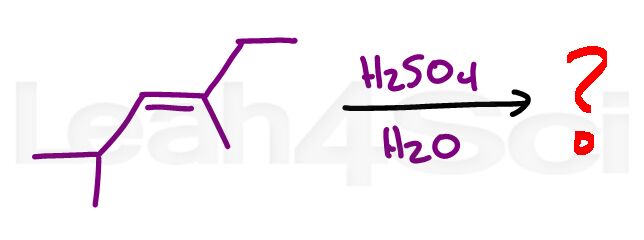
Hint: Don't overthink it. Sometimes tricky looking reactants yield simple products. Tutorial video here.
Alkene Practice Question 13
Identify the product when the following alkene reacts with HCl in CCl4.

Hint: This is a fun (read TRICK) question. Pay careful attention to the logic BEHIND Markovnikov's rule! Click HERE to study the reaction mechanism.
Alkene Practice Question 14
Identify the product when the alkene below reacts with HBr.
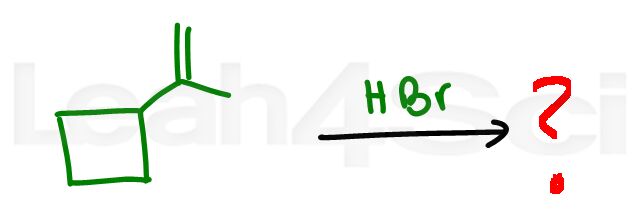
Hint: Other than degree of substitution, what ELSE can cause a carbocation rearrangement? Need help? Watch this video.
Alkene Practice Question 15
Identify the product when the alkene below is reacted with sulfuric acid.

Hint: There is no given solvent, don't make any assumptions 😉
How did you make out?
Compare your solutions to the answer key. Click the button below for details



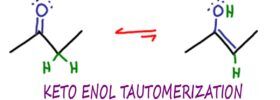
Dear Leah, thank you! Your videos are soooo helpful, I wish you all the best in your life, you deserve it! I signed more times for the solutions and never got the mail, also for some cheat sheets, never got anything 🙁 I also check my spam folder but nothing there. Could you please send them to me? Thanks!
Hey Leah for number 13, wouldn’t the Cl adds to the most substituted and H to the less substituted side? In your solution sheet has Cl adding to the less substituted side? Can you explain please!
Thank you for this awesome quiz! For number 8, though, I think an ethyl shift could be done for a minor product
Hola, for question #4 I believe that halogenation is an anti addition so the Cl atoms would be on opposite faces one wedged one dashed not both dashed.
For Q13, are there no ortho- and para-substituted aromatic compounds? Because secondary benzyl carbocation has resonance structure, which positive charge locates in benzine.
For Q.5 could the reagents also be 1.Hg(OAc)2, CH3OH and 2.NaBH4, H2O
Hi Leah! Your videos have all been a wonderful help!
I was just wondering why in question 7 when we have the formation of a carbocation, is there not have a hydride shift (since there is a tertiary carbon next to the cation)?
Mam Can u tell me reason for 13 and 5
Can u help me in getting key
the solutions aren’t sending to my email 🙁
Hey Leah, I was looking at the solutions, and it says that #6 is an alkoxymercuration. The end result had an Oh, so why is it not an Oxymercuraton?
Hi Leah,
I am not able to download the solutions via the link. It is not working. Can you please email me the solutions?
In question no.6 how will we decide which group will leave in the last step of mechanism (i.e. ethyl or hydrogen ion forming a product which is alcohol or ether)??
Hey Leah! Thanks for this practice sheet.It was a challenging one.I guess that the answer to Q6 is given wrong.It should be OEt instead of OH.And I couldn’t get Q15 .Could you please explain it to me?
also for Q13 there is something wrong
the solution for Q9 is wrong
Great practice, thank you Leah! You’re amazing! I would like to check my answers but the solutions have been taking a while to be sent. It is usual to take two hours?
HOlly: Should have been instant. Sign up again if you still don’t have it
I wish I’d seen this earlier! I’ve got the gist of the mechanism but I always get confused with the little things and this cleared it up SO MUCH. Thank you!
Better late than never Maria. Glad to help
Thanks for putting this together, it’s really helpful. For question 6, I think OEt should have added since ethanol is used as nucleophile not water.
You’re correct Wanda, it’s a mistake on the key
for number 6. How come the et group is not attached to the OH in the final product?
can you please send the solutions to my email? can’t download it. Pleasssse leah
Email me Jaey
Thank you!!! Your videos are sooo awesome! You saved me:)
Glad to help Liana
In Question 10 as six membered ring are more stable than seven membered ring (due to more angle strain in seven membered)the carbocation rearrangement results into hydrogen shift instead of ring expansion.Am I right?
6-member rings are more stable due to the ability to adapt a chair conformation and 109.5 degree bond angles
your explanations are awesome
but where are solutions
Did you click the link at the bottom of the page?
The videos i saw from you are the best, more then what my tutors gave and i really love it. you helped me alot thank you very much. By the way i’m from Papua New Guinea.
Than you glad to help
where is the solution?
Vincent: There’s a link at the bottom for the solution set
Hi Leah, 1) Q12: Would we end up with a racemic product? 2) Q8: Is it possible to have a minor product formed (in addition to what you have shown) where the OEt adds meta to the crazy arm?
Did you download the solutions Jen?
Yes. (Thank you!) I`m just wondering for Q12 and Q8, if it is possible to get some additional products. …basically I`m wondering if my ‘other’ answers could be right as well 😉
hi maam, i would just like to comment on the solutions you made particularly to the answer of question #6. Since it is an alkoxymercuration therefore the answer would be an ether. Maybe it is only a typo error but it is better to correct it in order to avoid confusion. Anyways, thank you for all the hard work. 🙂
Oh wow you are absolutely correct Feldan. I fell for my own trick!!!!! thanks for pointing it out
How do I check the solutions
I am not getting ans key it is taking lot of time but ur ques r very nice thanx mam